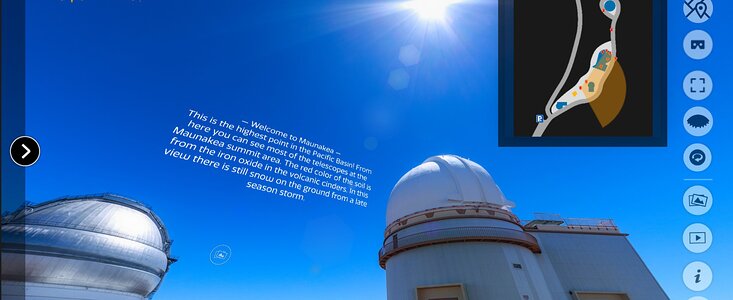NOIRLab Releases Updated Virtual Tours
An expanded set of interactive virtual tours has just dropped. Check them out!
14 May 2024
For many astronomy enthusiasts, few things instill as much excitement as visiting the U.S. National Science Foundation's world-class telescopes and research centers that are part of NSF NOIRLab. From the remote and rugged mountains of Chile to the towering slopes of Maunakea, from the rocky terrain of Kitt Peak to NOIRLab Headquarters in Tucson, Arizona, NOIRLab facilities span continents and hemispheres to bring the wonders of the Universe to the public.
Getting to these remote locations, however, can be difficult, even for the most adventurous travelers. That is why NOIRLab has brought the experience to you!
NOIRLab is proud to announce the launch of Version 2 of its comprehensive virtual tours, loaded with interactive elements that give special behind-the-scenes access to the facilities and diverse communities that make astronomy research possible. The entire suite consists of eight different locations, featuring panoramic images from various areas near the summit and base facilities of all our Programs, including the two telescopes that are part of the U.S. Extremely Large Telescope Program (US-ELTP).
These new Virtual Tours now include 100 additional high-resolution, 360-degree panoramas taken by a group of talented astrophotographers during the post-pandemic NOIRLab 2022 Photo Expedition to all sites in March and April of 2022. These photos were taken with a high level of care and expertise and are best explored from within the virtual tour environment in full-screen mode.
PC, Mac, iOS, Android, and Virtual Reality headsets are all supported by these tours. While using a mobile device, make sure to enable gyroscope access for the full immersive experience. NOIRLab’s collection of 360-degree panorama pictures can be used for both recreational and educational purposes; alongside being imported into Virtual Reality systems, they can also be downloaded in fulldome format for planetarium use. All panoramas are also available for free download in resolutions up to 500 megapixels.
The virtual tours include NOIRLab Headquarters in Tucson, Kitt Peak National Observatory southwest of Tucson on the Tohono O’odham Nation, Maunakea and the Hilo Base Facilities in Hawai‘i, Cerro Tololo Inter-American Observatory, Cerro Pachón and the AURA Recinto in Chile, and now the newly added Giant Magellan Telescope and the Thirty Meter Telescope, which make up the US-ELTP.
Go on an adventure and delve into NOIRLab’s Virtual Tours today!
More information
NSF NOIRLab (U.S. National Science Foundation National Optical-Infrared Astronomy Research Laboratory), the U.S. center for ground-based optical-infrared astronomy, operates the International Gemini Observatory (a facility of NSF, NRC–Canada, ANID–Chile, MCTIC–Brazil, MINCyT–Argentina, and KASI–Republic of Korea), Kitt Peak National Observatory (KPNO), Cerro Tololo Inter-American Observatory (CTIO), the Community Science and Data Center (CSDC), and Vera C. Rubin Observatory (operated in cooperation with the Department of Energy’s SLAC National Accelerator Laboratory). It is managed by the Association of Universities for Research in Astronomy (AURA) under a cooperative agreement with NSF and is headquartered in Tucson, Arizona. The astronomical community is honored to have the opportunity to conduct astronomical research on I’oligam Du’ag (Kitt Peak) in Arizona, on Maunakea in Hawai‘i, and on Cerro Tololo and Cerro Pachón in Chile. We recognize and acknowledge the very significant cultural role and reverence that these sites have to the Tohono O’odham Nation, to the Native Hawaiian community, and to the local communities in Chile, respectively.
Links
Contacts
Joy Pollard
Virtual Tours Project Lead
NSF NOIRLab
Email: joy.pollard@noirlab.edu
Mark Newhouse
Web & Graphics Manager
NSF NOIRLab
Email: mark.newhouse@noirlab.edu
Josie Fenske
Jr. Public Information Officer
NSF NOIRLab
Email: josie.fenske@noirlab.edu







